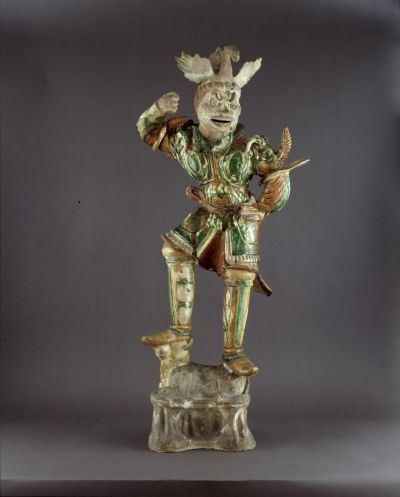
Lokapala (tianwang)
| Accession Nr.: | 54.308.1 |
|---|---|
| Type: | sculpture; funeral object; pottery |
| Date of production: |
First half of 8th century
Tang dynasty |
| Place of production: |
| Materials: | earthenware |
|---|---|
| Techniques: | glazed; painted; stamped |
| Dimensions: | height: 92.5 cm diameter (base): 24.5 cm |
By the end of the 6th century, with the arrival of Buddhism, depictions of dvarapalas (Sanskrit “gate-keeper”; Chinese tianwang, “heavenly king”), that is, armed and often frightening figures guarding the entrances of Buddhist shrines or niches and steles of cave temples, had appeared in China. Until the 9th–10th centuries they are shown in pairs, with ghastly faces and bodies bursting with strength. They are wearing armours and carrying weapons. They are wearing elbow-pieces and knee-pieces, and, as a rule, are standing on rock-like pedestals or treading on an animal. They are holding weapons in their hands. Their duty was to keep off evil creatures and troubles.
Earthenware burial figures formed a part of the funeral procession; they were carried on two-wheelers. When the procession reached the tomb, the figures were lined up along the two sides of the road, in a manner resembling the arrangement of colossal stone sculptures along ghosts’ roads leading to Chinese imperial graves. When the coffin had been placed in the grave, funeral figures were put there, too, so that they can fulfill their duty. In crypts in Henan and Shaanxi provinces dating to the mid-Tang period (late 7th century–early 8th centuries), dvarapalas were arranged in pairs, on the two sides of the entrance.
Earthenware burial figures formed a part of the funeral procession; they were carried on two-wheelers. When the procession reached the tomb, the figures were lined up along the two sides of the road, in a manner resembling the arrangement of colossal stone sculptures along ghosts’ roads leading to Chinese imperial graves. When the coffin had been placed in the grave, funeral figures were put there, too, so that they can fulfill their duty. In crypts in Henan and Shaanxi provinces dating to the mid-Tang period (late 7th century–early 8th centuries), dvarapalas were arranged in pairs, on the two sides of the entrance.